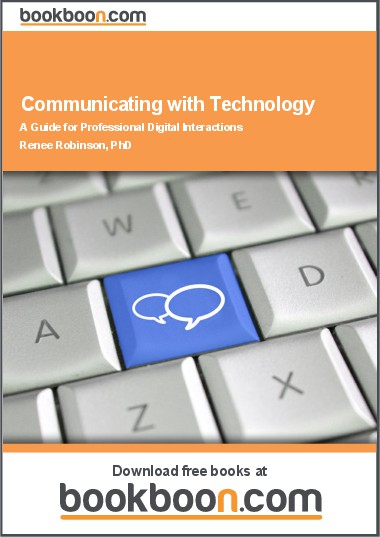Author Renee Robinson on the art of communication


Whether you like it or not, there is practically no way of avoiding technology. This is true in life and in the classroom. Have a look at our latest interview of Dr Renee Robinson, author of Communicating with Technology.
1. Whether with technology or without, what makes a good communicator?
A good communicator understands his/her audience and is able to formulate a message that is suitable to that audience. Part of sending an effective message is contingent upon selecting a channel of communication that best fits the content of the message and who the message is intended to reach. A good communicator is an excellent listener, whether communicating in face-to-face or computer-mediated contexts, and uses the feedback that he/she gathers from the audience to modify their message so that each party is able to understand what one another is sharing.
2. Have you had the experience of bringing technology into the classroom? Did you enjoy this new element?
I use a great deal of technology in the classroom. I’ve taught face-to-face classes as well as hybrid courses. In each instructional setting it’s important to assist students in critically thinking and communicating in digital spaces. This is especially important given a society that values technology and a workplace that expects employees to be technologically intelligent. To prepare students for personal and professional goals that will involve technology I adopt a BYOD (bring your own device) teaching philosophy. This model of teaching allows us to explore communication from multiple perspectives and channels while investigating the implications for the communication process through their uses. Personally, I love teaching this way and I love learning from my students about new devices as it relates to how we communicate with these new tools.
3. Were there any difficulties with the new type of teaching? Why?
Anytime an instructor adopts a new teaching tool it influences course content, pedagogy and practice. When working with technology a variety of difficulties can be presented. Some of these challenges concern bandwidth or Internet connectivity, campus support for a technology, a significant learning curve for the instructor understanding how to use the new tool and how students will use the technology to explore communication content. The use of technology, especially Web 2.0 tools, also requires that faculty provide opportunities for students that involve learners in communication, collaboration and construction activities that engage them in the course content. This activity alone changes the classroom structure resulting in the instructor no longer being the center of attention and knowledge and instead demands student centeredness. This is not an easy transition for many faculty to make.
4. Online personal branding seems to be the big expression these days. For someone who is not used to the online world, where should they start their personal branding activity?
One of the best places to begin developing a personal brand concerns self-reflection. Through self-reflection a person identifies what message they want to convey to others. It’s critical that the person knows what they represent and what goals they want to pursue. The brand is what helps them reach their goals. In terms of social media, LinkedIn is a great initial place to articulate that brand. As a social media tool, there is a low learning curve and the platform provides a template to help users convey their brand.
5. Towards the end of your book, you mention the “Communication Elements Checklist”. Do you have an example of when you had trouble communicating because of “cultural differences”?
The world is much smaller today given technology and our ability to communicate online. Globalization is changing our work world and our ability to travel is making it easier for us to connect to people around the globe. Cultural differences exist among coworkers, classmates and community members. I’ve been fortunate to avoid having trouble communicating with others who are from different backgrounds than mine. I believe this is due to my understanding and knowledge about communication. If I were to add one thing to the list of characteristics that makes a person a good communicator relating to the matter of culture difference, I’d note that with every communication interaction the people involved need to understand that we each come from different perspectives and places. These experiences shape how we view the world and because we are interacting with one another it is all the more important to try to understand what the other person is saying to us, what we want to accomplish from the interaction and how we can exit the exchange leaving one another with dignity and respect. There is nothing simple or easy about communication. It requires a great amount of attention, energy and time. It means putting down the day-to-day activity you are engaged in and really connecting to the person who is talking to you. Culture aside, if you don’t really engage in this kind of activity, difficulties will always emerge.
6. In your opinion, is there a danger of technology leading to less and less face-to-face time?
I don’t worry about less and less face-to-face time. I worry more about our how we treat one another when interacting with people across communication channels. Face-to-face communication has a specific purpose but so does every other communication context (e.g., groups, organization, mass media). Technology isn’t the issue; it’s the people who use technology that cause the challenges. Consequently, there is a real need to educate and train people about how to communicate appropriately, competently, and respectfully in various contexts and with various channels. Although my book focuses on work place digital interactions, its overarching goal is to help people connect digitally in effective, professional and successful ways.
Have a closer look at Dr Robinson’s book Communicating with Technology for more information. Enjoy!




